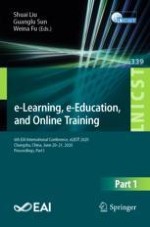2020 | Buch
e-Learning, e-Education, and Online Training
6th EAI International Conference, eLEOT 2020, Changsha, China, June 20-21, 2020, Proceedings, Part I
herausgegeben von: Shuai Liu, Guanglu Sun, Weina Fu
Verlag: Springer International Publishing
Buchreihe : Lecture Notes of the Institute for Computer Sciences, Social Informatics and Telecommunications Engineering
